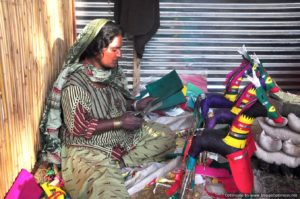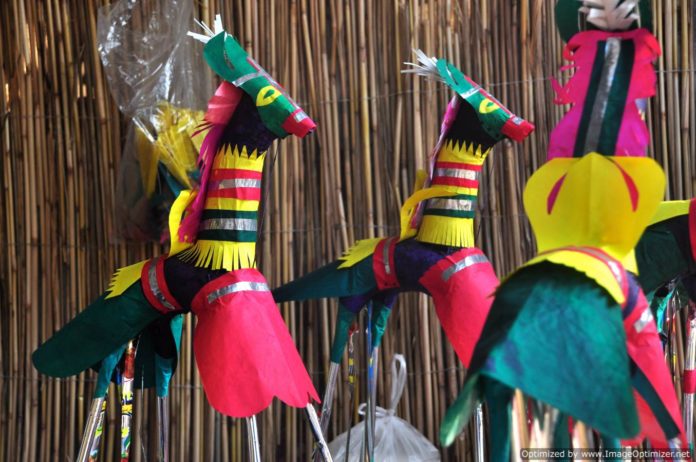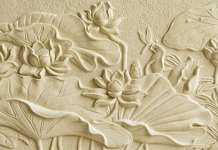Guggu Ghorey, or “children’s horses”, can be traced back to the pagan terracotta horses of the Indus Valley and to the votive clay offerings at the shrine of Ghorey Shah in Lahore.
 The first step in crafting the horse is to take pieces of rag cloth and stitch them together into shapes of neck and body of an animal. For the next step, known as bharai or filling and stuffing, the sack-like skeleton is filled with straw, so that it takes the body of a horse. With the help of needle and thread, the open mouth of the sack is stitched shut. Four bamboo sticks will now be attached to this body that function either as stilts or legs to make it stand.
The first step in crafting the horse is to take pieces of rag cloth and stitch them together into shapes of neck and body of an animal. For the next step, known as bharai or filling and stuffing, the sack-like skeleton is filled with straw, so that it takes the body of a horse. With the help of needle and thread, the open mouth of the sack is stitched shut. Four bamboo sticks will now be attached to this body that function either as stilts or legs to make it stand.
Recycled paper scavenged from garbage dumps or bought on the market is then soaked into coloured dyes. While the paper is left to dry, white glue is applied to the entire body of the horse. The next step is to cut the coloured/dyed paper and foil into variable shapes and sizes suit the different parts of the animal’s body—the head, the crown, the mane, the elongated neck, the chest, the flanks, the saddle and the legs. These paper cutouts are pasted on the horse, adorning its torso. The last step is to wrap the foil in thin bands and strips around the legs.
Manzur Malang, together with his wife Ghulam Fatima and brother-in-law, Mohammad Riaz, is the best-known living (and perhaps the only) craftsperson of sculptural horses. Like most craftspeople he can neither read nor write. He continues to practice the hereditary skill passed down to him by his paternal grandfather out of his homestead in Chah Deriwala in Khanewal District (Punjab, Pakistan).
Malang buys powdered pigments or dyes in yellow, pink, green, mauve and red at the local market in Multan. In addition, he buys silver foil of two different kinds, discarded paper as scrap that sells by the kilo, straw (bhoosa), white glue mixed with wheat flour, and bamboo sticks.




From where can I buy these Gugu Ghoray ?
from Multan Punjab small industries corporation chowk Rasheed abad khanewal road multan, 0619330417